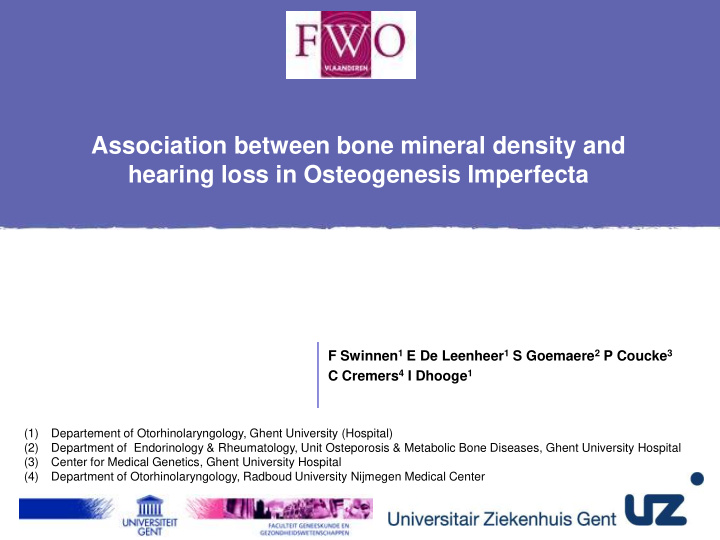



Association between bone mineral density and hearing loss in Osteogenesis Imperfecta F Swinnen 1 E De Leenheer 1 S Goemaere 2 P Coucke 3 C Cremers 4 I Dhooge 1 (1) Departement of Otorhinolaryngology, Ghent University (Hospital) (2) Department of Endorinology & Rheumatology, Unit Osteporosis & Metabolic Bone Diseases, Ghent University Hospital (3) Center for Medical Genetics, Ghent University Hospital (4) Department of Otorhinolaryngology, Radboud University Nijmegen Medical Center
I. Introduction 2/16 Osteogenesis Imperfecta (OI) - Hearing loss 50 % of OI patients OI types I, III, IV Mild to profound hearing loss, progressive Intrafamilial variability Hearing loss type: Conductive hearing loss Mixed hearing loss Pure high-frequency Pure sensorineural sensorineural hearing hearing loss loss
I. Introduction 3/16 OI - Hearing loss (2) Mixed hearing loss Conductive Sensorineural hearing loss hearing loss
I. Introduction 4/16 OI - Hearing loss (3) Conductive – Mixed Pure sensorineural loss Otosclerosis-like lesions: Cochlear hair cell atrophy stapes footplate fixation (and pericochlear lesions) Atrophy stria vascularis Ossicular discontinuity Perilymphe hemorrhage (fractured/atrophic ossicles)
I. Introduction 5/16 Computed tomography temporal bones Bilaterally severely progressed mixed hearing loss in a 67-year old OI-patient: severe pericochlear demineralization of bone
I. Introduction 6/16 Research aim Relationship between occurrence/type of hearing loss and generalized bone disease? Heterogeneity of hearing loss explained by variability in bone characteristics?
II. Methods 7/16 Patients and materials 56 adult OI patients (F: 34 M: 22) with identified mutation in COL1A1 or COL1A2 Mean age: 43 y. (SD 13.7) Bisphosphonates administration excluded Audiological evaluation Pure-tone audiometry Admittance measurements Stapedius reflex measurements Bone mineral density (BMD) measurements
II. Methods 8/16 Bone mineral density measurements Dual X-ray absorptiometry (DXA): areal BMD (aBMD) • Lumbar spine trabecular bone aBMD • Whole body cortical bone aBMD Peripheral quantitative computed tomography (pQCT): volumetric BMD (vBMD) • Radial metaphysis (4%) trabecular bone vBMD • Radial diaphysis (66%) cortical bone vBMD 4% 66% bone geometry parameters: cortical thickness, periosteal circumference, endosteal circumference
III. Results 9/16 Audiological phenotype 60 40% 46% 14% 50 40 30 44 20 25 24 10 12 4 3 0
10/16 III. Results Hearing loss as a function of OI type and genotype in 56 OI patients sensorineural conductive/mixed normal 60 60 50 50 40 40 30 30 20 20 10 10 0 0 COL1A1 COL1A1 COL1A2 OI type I OI type IV quant qual qual quantitative qualitative qualitative No association between hearing loss and mutated gene, type I collagen defect or OI type
III. Results 11/16 Hearing loss as a function of aBMD (DXA) DXA Lumbar spine DXA Whole body aBMD Z- score Normal Conductive/ Sensori- Normal Conductive/ Sensori- mixed neural mixed neural (N=19) (N=29) (N=8) (N=29) (N=8) (N=19) Mean z-scores < 0 (except sensorineural losses) ANCOVA [gender, weight, type I collagen defect] : sensorineural hearing loss > conductive/mixed hearing loss and normal hearing (P<0.05)
III. Results 12/16 Hearing loss as a function of vBMD (pQCT) pQCT radial metaphysis: pQCT radial diaphysis: Trabecular vBMD Z- score cortical bone trabecular bone Cortical vBMD (mg/mm 3 ) Normal Conductive/ Normal Conductive/ Sensori- Sensori- mixed neural mixed neural (N=19) (N=29) (N=8) (N=19) (N=29) (N=8) ANCOVA [gender, age, type I collagen defect] for (trabecular vBMD z-score *hearing): conductive/mixed hearing loss < normal and sensorineural hearing loss Radial diaphysis: no differences in cortical vBMD or bone geometry parameters
III. Results 13/16 Between-relatives comparisons of BMD and hearing Family number Family number OI patients with conductive/mixed hearing loss have lower BMD compared to their normal hearing relatives with OI
14/16 IV. Discussion OI patients with conductive/mixed hearing loss have lower BMD than patients with normal hearing or pure sensorineural loss OI patients with pure sensorineural hearing loss have higher aBMD than patients with normal hearing or conductive/mixed hearing loss (small sample + highest mean age) No differences in volumetric cortical bone mineral density or bone geometry parameters measured at radial diaphysis: ! Cortical vBMD: unreliable parameter when cortical thickness < 2.0 mm (spatial resolution too low)
15/16 V. Discussion Temporal bone : • Cortical bone • Bone formation complete at age 1 year • Bone remodeling is minimal Association conductive/mixed hearing loss and lower BMD: accumulating microfractures and fatigue microdamage destruct the osteoprotegerin (OPG) pathways which regulate temporal bone remodeling inhibition ? Future perspectives : • Replication in large population • Histological investigations of OI temporal bones • Effects of bisphosphonates on hearing in OI
16/16
Recommend
More recommend